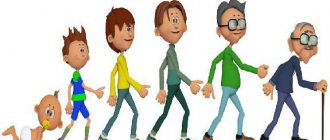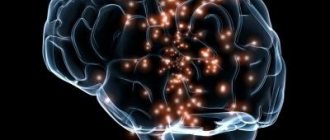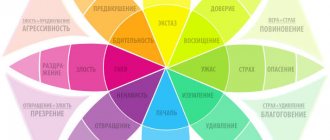Updated July 24, 2021 804 Author: Dmitry Petrov
Hello, dear readers of the KtoNaNovenkogo.ru blog. This term has taken root in the vocabulary of psychologists and psychiatrists, gamers and programmers, physicists and doctors. The word “trigger” comes out of the mouths of teenagers and PhDs. What is the reason for this popularity?
Well, it would be nice to at least in general terms understand its meaning in various areas, so as not to get into trouble. I think it’s time to figure out what a trigger is and what you eat it with (or is it inedible?).
The general essence of the concept of Trigger
The word “trigger” translated from English means “ trigger ”, “launch”. The literal translation reflects the essence of this concept:
an element that powers a system.
An analogy with a weapon will help to visualize the meaning of this mysterious term. When the trigger is triggered, the sound of a shot is heard (an active action occurs, the situation changes). A trigger is a pressed hook, in other words, a stimulating kick, Gagarin’s “Let’s go!”
It sounds vague because the term has multiple meanings. This is just the essence, and kicks, events and situations are different. This means that the term can have different meanings. Now let's move on to specifics, and everything will become clear.
What is a trigger in psychology
Psychologists, speaking about a trigger, draw an analogy (what is this?) with a toggle switch, which temporarily “switches” a person’s thoughts and forces him to perform unconscious actions. “Switches” can be any signals entering the brain (auditory, tactile, visual, olfactory, gustatory).
Psychological triggers are a factor that is not traumatic in itself, but can cause strong re-experiencing of a past experience (or its individual elements).
How it works
A person has a developed sensory memory (even someone who was never able to learn “Lukomorye has green oak” at school), and this sometimes makes life very difficult.
Under the influence of irritants (smells, melodies, photographs, stills from films, snatches of phrases), strong memories awaken. Everything is long in the past, but the brain helpfully draws a parallel with the present. “The legends of deep antiquity” suddenly evoke real emotions, and often actions.
Psychological triggers vary in their impact. Some cause an uncontrollable storm of emotions and actions, while others are easily overcome.
Here is a visual picture:
- A girl who has undergone treatment for anorexia, when she sees a photograph of a very thin man, begins to starve herself again.
- An elderly person, noticing a queue in a store, without hesitation stands in it: they are offering something worthwhile (“they threw away” a scarce product), you have to take it!
- A woman experiences panic attacks every time she inhales the scent of blooming lilacs: she felt it when she was attacked by a rapist in the park.
- A procrastinator logs into a social network and “turns it off” for an indefinite period of time. No one knows when he will return to work.
A trigger can cause an emotional reaction before a person even understands why they suddenly feel scared or sad.
Breaking free from influence: how to overcome psychological triggers
There is no need to be afraid of triggers, you need to learn to control them, and then the influence of the “triggers” will disappear.
First, it is important to understand: what exactly triggers the mechanism that turns on the “autopilot”? The answer to this question will help you see the situation somewhat detached when faced with a trigger, and this will make it easier to control it. If you recognize the onset of an undesirable reaction in time, it will be easier to extinguish the emotional outburst and prevent unconscious actions. Follow your feelings !
To suppress the unwanted impulse from the appearance of a trigger, it is worth looking for alternative methods of behavior. The smell of lilac and a rush of panic? We mentally read “Lukomorye has a green oak tree”! A little exaggerated (what is this?), but the essence is clear.
Types of psychological triggers
- Crowd of people. When we see a crowd of people gathering somewhere, a strong interest is immediately formed. I want to come up and find out what is going on and what people are interested in. This desire will be like a sudden impulse within, pushing towards the crowd.
- Sharp sounds. Not every person outwardly reacts sharply to a sudden cry, but there is always a reaction inside. A thought associated with danger immediately arises in my head. The brain reacts to this picture with a surge of adrenaline, which makes you turn to the scream and decide on further actions.
- Phrases. If you hear a phrase that a loved one or abuser said to you in the past, you will unconsciously be overcome by corresponding emotions.
Triggers can affect us in varying degrees of intensity. We can immediately leave some without experiencing discomfort, while others begin to control us. In order not to be a hostage to triggers, it is worth analyzing their nature and finding ways to control them.
Triggers can really interfere with our lives, but we shouldn't blame ourselves for it. As soon as it begins to act, a person begins to feel as if in a fog. It turns out that further actions will be performed on “autopilot”. It happens on its own. Then the person will not even remember and will not be able to explain why he reacted this way, why he bought an unnecessary thing, hit another person, or left for another city.
Trigger is a marketer's weapon
This term is very loved by marketers because it serves them without fail, bringing profit. Having studied what it is in terms of psychology, sales specialists build entire marketing strategies based on creating mechanisms that trigger the desire to buy.
Really good marketing triggers are:
- A temporary constraint that hints at scarcity. “Prices are valid until the end of the month,” or something like that. If we are talking about an online store, the picture is often complemented by a countdown timer. And now it clicks in my brain: buy it urgently, otherwise I’ll miss the chance!
- Thirst for free acquisitions. “2 products for the price of 1”, “Buy and get this very valuable thing as a gift”, “Every third bun is 50% off” - sound familiar? The bonus system is a chord from the same song.
- Bestseller. “If everyone buys it, I’ll buy it too. After all, I’m no worse than others!” Crowd trigger in action.
- Common habits and attitudes. The phrases “GOST”, “taste of childhood”, “German quality” are often decisive when choosing.
- Fear is a trigger that always hits the target. Everyone is afraid of something: extra pounds, loneliness, old age, illness, mice, poverty...
- The desire to have something exclusive. Buy an author's course, a unique blouse, a handmade bag - few people can resist such an offer!
A video filled with marketing triggers from start to finish:
It is difficult to resist such tricks, but it is possible. The recommendations from the previous section are also relevant here. Know the “enemy in person”, listen to your feelings in order to prevent spontaneous actions.
Do you have an irresistible desire to buy 7 packages of cereal for the price of 6? We exhale and act according to a proven scheme: Pushkin, “Lukomorye”. Helps!
Triggers in circuit design
The moment has come for the transition from poetry to physics (it won’t do without computer science either): the concept of “trigger” is actively used in computer technology and electronics.
This is the name for pulsed electronic devices (transistors, thyristors, comparators) capable of remaining for a long time in one of two stable states , alternating under the influence of external signals. In essence, it is an externally controlled (by small electrical signals) valve with two positions - open or closed (zero or one).
In addition, these devices have the ability to store binary information. They are used in various elements of computing systems: processors, registers, random access storage devices. There are billions of these “triggers” alone.
Typically, flip-flops are used to generate an output signal, which is perceived as enabling or informing other nodes of a digital circuit (“the process is in progress!”). “Process flag” is how these devices are often called. The number of trigger inputs depends on its functional purpose, and there are usually two outputs: direct and inverse.
According to the method of recording information, there are asynchronous and synchronized (or clocked) triggers. In asynchronous recording is continuous; it is determined by information signals acting at a particular moment at the inputs. If this happens only during the action of the synchronizing signal, then we are talking about a clocked trigger.
Among such devices, the Schmidt trigger especially stands out. This is the name of a two-position switching element (it has one analog input and one two-level output) with a hysteresis loop (translated from Greek as “delay”, “lag”: the system reacts to the influence depending on its current state).
Schmidt triggers are actively used in electronic devices to reduce interference in circuits, especially in circuits whose purpose is the interaction between digital and analog sections: the digital signal here can be distorted.
In electronics
Any storage device cannot do without a trigger. This is the main element of any system of such a device. Most often, triggers store a small amount of information. Typically, this includes various codes and bits.
Triggers are classified as RAM due to the fact that they retain their memory if there is an element that will power them.
There are many types of triggers in electronics. Different types can be found in different devices. Most often it is used to create and transmit a signal.
Video about what a trigger is in electronics:
What is a trigger in medicine
The term we are interested in is often heard in medical circles (and not only among psychologists and psychiatrists). Doctors call triggers a provoking factor , under the influence of which changes begin in the body (usually unfavorable).
The medical concept of “trigger” is strongly associated with asthma, migraine, epilepsy - chronic diseases that periodically worsen under the influence of weather conditions, environmental factors, and food (they act as a “trigger” ).
In hypnosis, the word “trigger” refers to a kind of “key” that is established during a session. It is used to instantly put the patient into hypnotic sleep.
Another medical concept on the topic that interests us is “ovulation trigger.” This is the name for specialized medications that stimulate the ovulation process in women with reproductive system problems. Most often, this “trigger” is human chorionic gonadotropin (hCG).
trigger points is also used in medicine . These are special areas on the body that are hypersensitive to external influences due to local muscle spasm. Most often they are located in muscle tissue.
To the touch, these places look like small hard lumps. When you press them, pain sharply “shoots out”, hence the name. To get rid of such pain areas, you need to consult a neurologist: Pushkin will not help here.
What is this on Instagram
Instagram is a social network that almost every Internet user knows about. Using the application, a person gets rid of boredom. After all, here you can find entire stores, a lot of entertainment content, learn about the lives of your friends and celebrities, and just watch funny videos, relaxing after a hard day.
Gradually, a person is drawn into this social network and can no longer live without it. Soon the fear of missing out on new publications and comments will begin to appear, which will cause stress. Instagram itself creates a number of habits among its users.
This application itself is an external trigger. How often does it appear on the page of other social networks? How often do friends and relatives refer to this portal? A person, willy-nilly, is imbued with Instagram, stepping towards the already internal triggers. Now the application itself hides a call to a particular action. More often, this can be found in various sweepstakes and store accounts.
What does this mean for gamers?
If you hear the word “trigger” in a conversation between two teenagers, it does not mean that they are discussing the principle of the Schmidt valve or an effective marketing strategy. Most likely, we are talking about a computer game, and these teenagers are gamers.
With this term they call various mechanisms or objects, the action of which in one way or another affects the development of the game plot (an explosion is heard, an enemy attack begins, etc.).
There are triggers that move selected objects in any direction, changing their color and transparency (this also works in relation to the environment). With the help of proper use of the “trigger” mechanism in the game, you can destroy an object and restore it.
Here are a couple more concepts from the world of computer games on the topic:
- Trigger zone - a section of the game space that tracks the presence or absence of any object;
- Trigger point is a “trigger mechanism” by which the player checks the distance from himself to the object of interest.
The world of computer games is full of diverse “triggers”; new ones appear periodically. There is even a virtual switch that can override other switches. Oh, how! And you thought that games were just...











